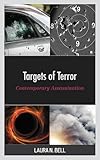Targets of Terror : contemporary assassination / Laura N. Bell.
Material type: TextPublication details: Lanham: Rowman & Littlefield, 2021.Description: 179 Pages; 23 cmISBN:
TextPublication details: Lanham: Rowman & Littlefield, 2021.Description: 179 Pages; 23 cmISBN: - 9781786613912 (hbk)
- 364.152/4 23
- HV6278 .B433 2021
| Item type | Current library | Collection | Call number | Copy number | Status | Notes | Barcode | |
|---|---|---|---|---|---|---|---|---|
 Books
Books
|
Rabdan Academy General Stacks | General Collection | HV6278 .B433 2021 (Browse shelf(Opens below)) | C. 1 | Available | AED 309.31 | 22809 |
Browsing Rabdan Academy shelves,Shelving location: General Stacks,Collection: General Collection Close shelf browser (Hides shelf browser)

|

|

|

|

|

|

|
||
| HV6252 .A416 2015 Routledge handbook of transnational organized crime / | HV6252 .A442 2022 The Routledge Handbook of Transnational Organized Crime / | HV6252 .S562 2023 الأمن السائل / | HV6278 .B433 2021 Targets of Terror : contemporary assassination / | HV6419 .H268 2021 Internal Security and Technology : opportunities and challenges / | HV6419 .H373 2022 الأمن الداخلي والتكنولوجيا : الفرص والتحديات / | HV6419 .H373 2022 الأمن الداخلي والتكنولوجيا : الفرص والتحديات / |
Includes bibliographical references and index.
Introduction -- Characterizing contemporary assassination -- The data and the targets -- Target selection and political institutional changes -- Government officials -- The politically active -- Law enforcement -- Journalists -- Military and religious leaders -- Understanding terrorist assassinations.
"Targets of Terror: Contemporary Assassination, aims to address the repercussions of assassination as a tactic of terrorism and delineate post-assassination political and societal outcomes across target type. Assassination of heads of state, such as John F. Kennedy and Yitzhak Rabin, are rare events but the political murders of police personnel, local government officials, politicians, and journalists occur frequently. These 'softer' targets (low-level and mid-level government officials, for instance) are often targeted during broader campaigns of terrorist violence and the Global Terrorism Database (GTD) records a significant number of these assassination events-16,246 to be exact-between 1977 and 2017. Both qualitative and quantitative methods are utilized in this project-using survival analysis to examine the span of time from a terrorist assassination to potential shifts in state political institutions. Changes in political institutions in authoritarian, mixed or tumultuous regimes are compared against democratic regimes (utilizing Polity score changes from the Polity IV Index as the indicator of institutional change and detailed further below). Repressive and non-repressive regimes are delineated and changes in political institutions are examined in order to determine the extent to which the type of assassination target may or may not be linked to political institutional change. The assassinations and target data is derived from the GTD and repression levels are measured using the Political Terror Scale (PTS). Establishing differences in post-assassination political outcomes across regimes and target types provides a baseline study upon which to build future examinations of the types and severity of risks to governmental institutions as well as to the broader society"--
There are no comments on this title.
